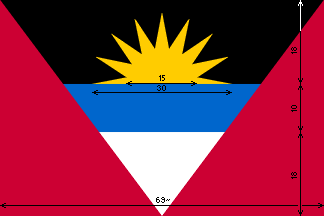
by Zeljko Heimer, 12 January 2001
Flag adopted 27 February 1967, coat of arms adopted 16 February 1967.

Last modified: 2003-04-26 by dov gutterman
Keywords: antigua | barbuda | caribbean | america | antigua and barbuda | agave | west indies | leeward islands |
Links: FOTW homepage |
search |
disclaimer and copyright |
write us |
mirrors

by Zeljko Heimer, 12 January 2001
Flag adopted 27 February 1967, coat
of arms adopted 16 February 1967.
See also:
Antigua and Barbuda's flag was designed by Mr. Reginald
Samuels, an art teacher in an Antiguan high school, when
Antigua gained "statehood" status (Self-governing) in
1967.
L. Jacobs II , 21 September 1998 and Ivan Sache ,
31 January 2000
Acording to L'Album 2000 [pay00]
the construction details are stripes in ratio 18:10:18, lenght
69~ [so total ratio 2:3~]. Is this based on some official data?
[smi80] have as civil ensign for
Antigua and Barbuda to be the british red ensign, but here the
national flag is indicated to be (among other uses) civil ensign
too. Is that changed since 1980?
Zeljko Heimer, 5 January 2001
I visited Antigua in spring 1994 and I saw there a lot of
national flags, both on land and at sea.
Ivan Sache, 6 January 2001
The flag is national flag and ensign (i.e. CSW/CSW). The flag
was adopted, apparently only for the use on land in 1967, but the
flag must have been introduced into maritime use since 1981 when
Antigua and Barbuda aquired full independence. Until 1981 the
undefaced red ensign was the civil ensign in Antigua and Barbuda.
Was there any defaced blue ensign?
History of the status of AG could be quoted from rulers site <www.geocities.com/Athens/1058/rulers.html>:
Zeljko Heimer, 12 January 2001
Example of gold on flags as opposed to yellow was given
recently by the embassy of Antigua Barbuda in London, who sent a
delivery of flags back to their manufacturer recently on the
grounds that they (the manufacturers) had used yellow where the
law stipulates a 'golden' sun.
Christopher Southworth, 28 March 2003
The sun represents the dawning of a new era; red - the energy
of the people; blue - hope; black, the African ancestry of the
people. The combination of yellow, blue and white represent the
sun, sand and sea.
James Dignan , 22 November 1995

by Zeljko Heimer, 12 January 2001
The construction sheet is made according to the data given in
l'Album 2000 [pay00]. Overall
ratio 2:3~ is approximated as (18+10+18):69~. The sun symbol is
half of a 16-pointed star with outer diameter 30 and inner 15
units. The colours provided are approxiamtive. The red is
apparently the same as the red of the british ensigns (Pantone
186c). This seems a bit purpulish when reverted to BS (204-0-51).
Blue is somehwat lighter then the standard British ensign blue
(Pantone 300c) and yellow is aproximated with Pantone 116c.
Zeljko Heimer, 12 January 2001
.jpg)
from Ralf Hartemink site
One of the stags that support the Antigua and Barbuda shield
holds an agave which repesent connection to the rope industry.
Nahum Shereshevsky, 31 May 1997
According to the CIA World Factbook, Antigua and Barbuda
comprises six parishes and two dependencies. The two dependencies
being the islands of Barbuda and Barbuda. Evidently all the parishes
are on Antigua.
Joe McMillan, 9 April 2003
Encyclopaedia Universalis Yearbook lists the administrative
divisions as follows:
Parishes:
- St. George
- St. John
- St. Paul
- St. Phillip
- St. Peter
- St. Mary
Other islands:
- Barbuda
- Barbuda (uninhabited).
Ivan Sache, 11 April 2003